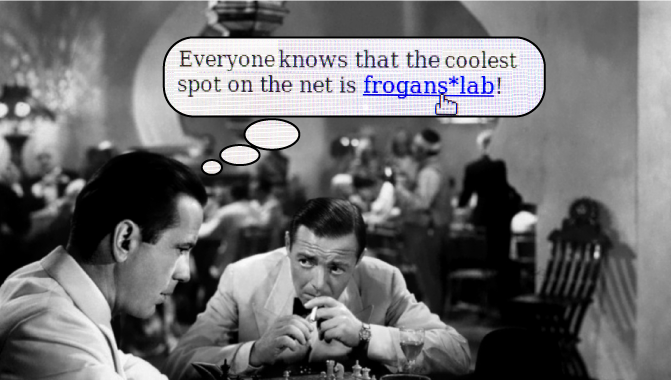
Share a link to a Frogans site?
Let’s say that you have authored a Frogans site and are ready to share it with the world using a Frogans address. So you write up an email to all of your friends, family and colleagues telling them of the great news. You tell everyone to make sure that they have downloaded Frogans Player so that they can visit your site. And of course you paste in your new Frogans address.
But
then you get a bunch of emails back from your friends, family and
colleagues saying the same thing:
“Thanks
for the wonderful news, but when I try to click on your Frogans
address, nothing happens.”
Of course nothing happens
Software like Email clients are able to detect URLs and email addresses. Typically, email client will send the mail that you compose in HTML format with URLs and email addressed shown as links.
But it’s going to take some time before email clients, Web browsers and the like will even be able to accommodate click-able Frogans addresses. The good news is that there is a clear path for making this happen, thanks to RFC 8589: “The ‘leaptofrogans’ URI Scheme.”
Just this last May, The Internet Engineering Task Force (IETF) published the first Request for Comments (RFC) specifically related to Frogans. It describes the “leaptofrogans” uniform resource locator (URI).
If that sounds like gobbledygook, let’s look at the whole kit and caboodle, one crazy acronym at a time…
The Internet Engineering Task Force (IETF)?
How
is it that zillions of different kinds of machines (PCs, phones and
tablets, cloud-based services, video game terminals and much more)
can all be hooked up to this thing we call the Internet and
everything pretty much works? The short answer is that these
different machines talk to each other according to the same global
standards.
The
IETF is an open standards organization of volunteers from around the
world. It operates through a bottom-up process by which all decisions
are based on consensus. In this sense, you might say that the
Internet itself functions through consensus more than through any
imposed set of rules.
For
the formalization of voluntary Internet standards, as well as for
other related communique, the IETF publishes RFCs.
RFCs?
The first Request for Comments was written in 1969 for keeping track of developments in the ARPANET, the project from which today’s Internet would eventually evolve. Over time, a peer review-based system for the approval of proposed RFCs was developed. Needless to say, the bar for the approval of an RFC is quite high and the process can take years.
Imagine
that each RFC is a chapter in the history of the Internet in terms of
its core standards technologies. From that perspective, the
“leaptofrogans” URI scheme is the 8589th chapter in
the Internet’s history.
So,
what is a URI scheme?
A URI scheme is the way in which you encode a Uniform Resource Identifier (URI) in a document like a web page, an email or even in an app for identifying a particular resource. For example, the “mailto” URI scheme allows you to encode an email address and thus open an email client for sending an email to that address, and the “http://” URI scheme allows the same thing for Web addresses in Web browsers. For example, here’s how you would do this in HTML:
<a href="mailto:[email protected]">[email protected]</a>
and
(respectively)
<a href="http://bar.com">bar.com</a>
The
‘leaptofrogans’ URI Scheme
So, by the same token, you would use the “leaptofrogans” URI in HTML to encode a link to open a Frogans site in Frogans Player:
<a href="leaptofrogans:frogans*lab">frogans*lab</a>
What? You say that you encoded this in a Web page and it didn’t work? What good is RFC 8589?
RFC
8589
RFC 8589 is an “informational” RFC that serves as a guide for developers of applications, such as email clients, Web browsers and more, to implement the “leaptofrogans” URI scheme (see also the official URI schemes registered with the IANA). Nobody is under any obligation, but RFC 8589 establishes a clear path for enabling direct links to Frogans sites in online content.
So right now, we are still a ways from seeing click-able links to Frogans addresses online and in emails. Already, we shouldn’t expect much before the Frogans technology is released in its complete form, but hey, as Rick said to Ilsa in Casablanca:
“Maybe not today … maybe not tomorrow, but someday soon, and for the rest of your life!”
Update: frogans*lab

Leave a Reply